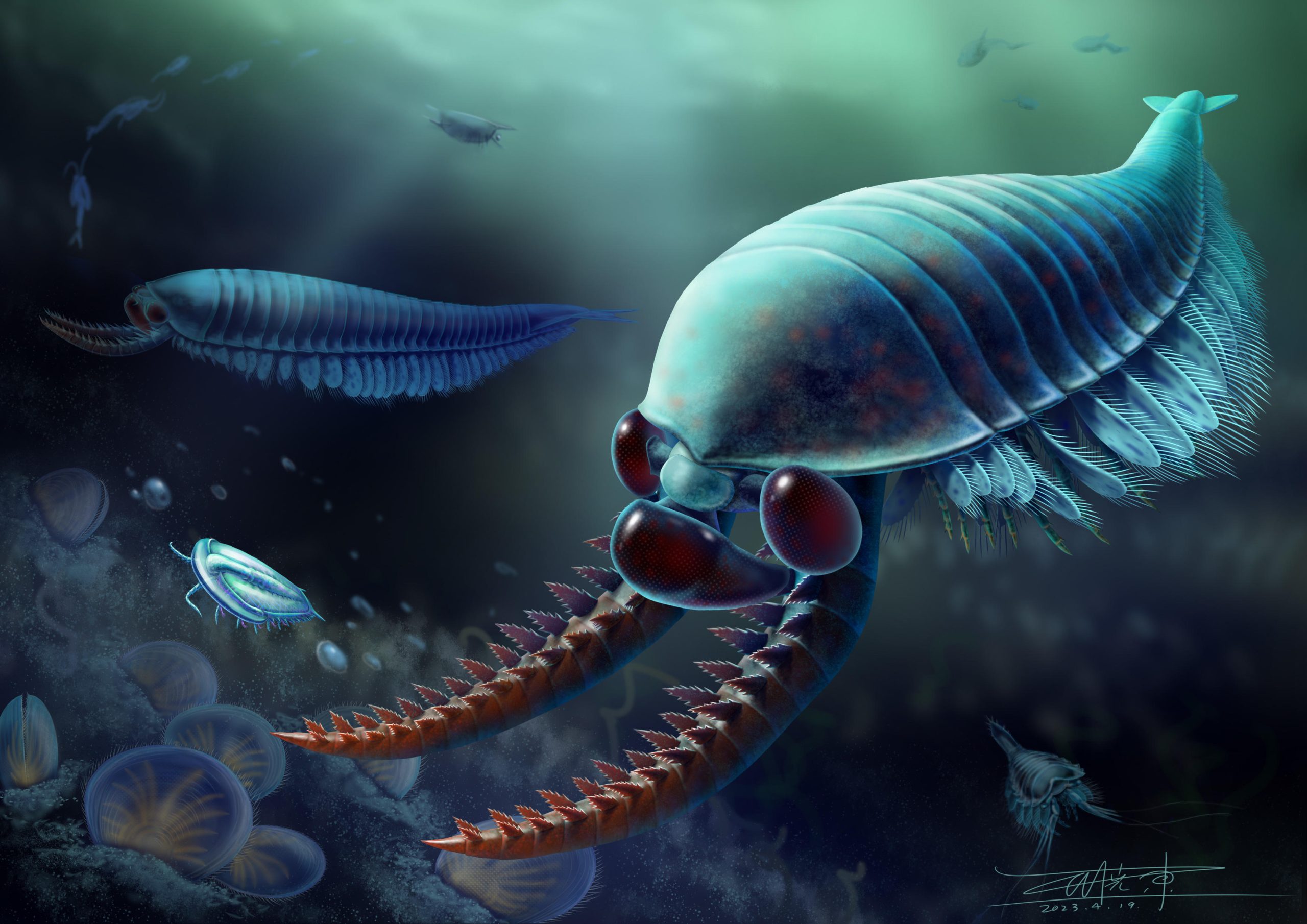

Technical reconstruction kylexia. Credit: X Wang
Researchers from the University of Leicester and the Yunnan Key Laboratory of Paleobiology have used advanced scanning technology to recreate a “fossil monster” that lived half a billion years ago.
A collaborative team including researchers from the University of Leicester, the Yunnan Key Laboratory of Paleontology, the Institute of Paleontology of Yunnan University, the Zhengjiang Fossil Museum and the Natural History Museum in London re-examined a unique fossil animal found nearly 520 million years ago. ancient rocks. This reassessment helps fill a knowledge gap in the evolutionary history of animals known as arthropods.
The animal that bears the scientific name kylexia, It was imaged with a CT scanner which revealed its soft anatomy buried in the rock. About the size of a large shrimp, its striking features include three eyes on the head and a pair of fearsome limbs that are supposedly used to catch prey.
The study was recently published in the journal Current Biology.

Sectional images of fossil animals Kylinxia arangi from southern china. The size of the animal is the size of a large shrimp, and the front end to the right. This image clearly shows the segmented body and large eyes from the front. Credit: Courtesy of Professor Yu Liu, Yunnan University
Fossils of many types of marine animals first appeared in rocks about half a billion years ago, and point to a time when complex ecosystems were developing in the world’s oceans. One of the main areas for such fossils is the area around the town of Qingjiang in southern China, where the fossils were collected for this study by the Chinese team. Fossils of organisms were recovered from the Cambrian region of Zhengjiang, Yunnan Province, of which more than 250 classify Exceptionally well-preserved fossil organisms have been described.
The new discovery is important for deciphering the history of arthropods. They are animals whose bodies are divided into parts, most of which bear a pair of articulated limbs, such as crabs, lobsters, insects, and spiders.

Sectional images of fossil animals Kylinxia arangi from southern china. This photo shows the large forelimbs extended. Credit: Courtesy of Professor Yu Liu, Yunnan University
Although there are plenty of arthropods in the fossil record–the most famous being the trilobites–the vast majority of them only preserve their rigid skeletons. Because the new Chinese material is almost completely preserved, the team was able to image a head kylexiaSix segments are identified: the anterior one bearing eyes, the second containing a pair of large prehensile limbs, and the other four each bearing a pair of jointed limbs.
Study lead author Robert O’Flynn, Ph.D. A student in the University of Leicester’s School of Geography, Geology and Environment said: “The preservation of a fossil animal is amazing. After doing a tomography, we can digitize it and literally stare into the face of something that was alive over 500 million years ago. As we rotated the animal, we were able to seeing that its head has six segments, just as it does in many living arthropods.

Micro-CT model. kylexia Show features in the header. Credit: Courtesy of Professor Yu Liu, YKLP
Professor Mark Williams, Robert’s principal supervisor at the University of Leicester, said:kylexia, and the Chengjiang biota from whence they come, play a fundamental role in building our understanding of the early evolution of arthropods. I like to think that similar discoveries Robert will continue to make.
“Robert and I were examining CT data as part of his doctoral thesis in hopes of improving and correcting the previous interpretation of head structures in this genus, Kylinxia,” said Professor Yu Liu of the Yunnan Ke Laboratory of Palaeobiology. Surprisingly, we found that its head consists of six segments, as, for example, in insects.
Dr Greg Edgecombe, from the Natural History Museum, added: “Most of our theories about how cephalopods evolved have been based on these early branching species having fewer segments than living species. The discovery of two pairs of legs that had not been discovered before kylexia indicates that living arthropods inherited a six-segmented head from an ancestor at least 518 million years ago.
Reference: “Early Cambrian Kylinxia zhangi and the evolution of the head of arthropods” by Robert J. O’Flynn, Yu Liu, Xiangwang Hu, Huiguan Mai, Mengxiao Yu, Songling Zhuang, Mark Williams, Jin Guo, and Gregory D Edgecombe August 28, 2023, Current Biology.
DOI: 10.1016/j.cub.2023.08.022
The study was funded by the Yunnan Provincial Science Foundation.

“Web maven. Infuriatingly humble beer geek. Bacon fanatic. Typical creator. Music expert.”





More Stories
Scientists confirm that monkeys do not have time to write Shakespeare: ScienceAlert
SpaceX launches 23 Starlink satellites from Florida (video and photos)
A new 3D map reveals strange, glowing filaments surrounding the supernova